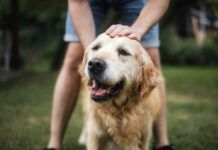[Updated August 3, 2018]
We want our dogs to live forever, but they don’t remain puppies for long. By the time they reach middle age, most dogs start to slow down because of arthritis, illness, injuries, or the aging process. Being overweight makes all of these problems likely to occur at a younger age.
Exercise is essential for dogs of all ages. It helps maintain muscle tone, a healthy weight, joint flexibility, good circulation, and overall health and happiness – but when movement causes pain, it’s only natural to slow down or stay still. That creates a vicious cycle in which inactivity contributes to pain, pain reinforces inactivity, and the dog’s health deteriorates.
How can you safely help your sedentary older dog resume an active lifestyle? Here are some exercise do’s and don’ts.
DO:
1. Go to the vet.
Before starting an exercise plan, take your best friend to your veterinarian, who can check his weight, overall condition, and range of motion. (When you schedule the appointment, be sure to let the staff know that you want an in-depth wellness examination, not a cursory appointment.) Your vet can then help you plan an effective exercise strategy.

2. Consider physical therapy.
Consider seeing a Certified Canine Rehabilitation Therapist (CCRT), the veterinary version of physical therapists for humans. CCRTs design exercise programs for individual dogs to help them recover from injury and safely improve their strength, balance, and range of motion.
Ask your vet for a referral to a CCRT or check with the Canine Rehabilitation Institute, the University of Tennessee Canine Rehabilitation Certificate Program, or the American Association of Rehabilitation Veterinarians.
3. Have your dog lose weight.
Help your overweight dog lose weight, as that’s one of the best things you can do to help an older dog remain mobile. It also helps to feed a diet that doesn’t contribute to inflammation.
For weight-loss tips and recommendations, see “Identifying Arthritis in Dogs,” WDJ October 2016, and “Helping Your Dog Lose Weight,” September 2009.
Note: An article on “Weight Loss for Older Dogs” will appear in the January 2017 issue.
4. Start exercising your dog little by little.
Help your dog start exercising gradually, starting with short, low-impact walks on smooth or flat surfaces. Watch for symptoms like limping, wanting to rest, or other signs of discomfort, and let your dog take breaks as needed. When starting an exercise program, soreness the next day indicates that you did too much. Exercise can be increased gradually as long as it doesn’t make the dog feel worse.
5. Go swimming!
If she enjoys the water, take your dog swimming, as swimming puts less pressure on sore joints than walking or running. Some veterinary clinics have therapeutic swimming pools or underwater treadmills that help arthritic dogs exercise without stressing their joints.
6. Play games!
Play games that your dog enjoys to keep him active and interested, such as hide and seek. Keep the game short (10 minutes or less) and simple.
“I have to put in a plug for nose work and sniffing games,” says WDJ contributor Mary Straus, “because they tire dogs out without strenuous activity. We have dogs competing in nose work at very advanced ages who are no longer able to participate in other activities.” For more information about K9 Nose Work, see “Sniff This – You’ll Feel Better,” (WDJ, April 2013) and the National Association of Canine Scent Work.
7. Try supplements for dogs.
Experiment with nutritional supplements (“Identifying Arthritis in Dogs,” WDJ October 2016), medicinal herbs (“Herbal Remedies for Arthritis Pain,” November 2016), essential oils (“Therapy That Smells Great,” this issue), and other remedies that may increase your dog’s range of motion and activity level.
8. Give your dog a massage.
Hire a canine massage therapist or learn basic massage techniques and use them to improve your dog’s flexibility, circulation, and muscle tone. Massage helps relieve stiffness and joint discomfort, and speeds recovery from accidents and injuries. As a bonus, massage can deepen the bond between pets and people. For guidelines, search for books on canine massage at DogWise.com or visit petmassage.com or dogmassage.com.
DON’T:
1. Strain your dog.
Don’t strain your arthritic dog’s joints by playing catching games, spinning, running on sand or other soft surfaces, running on streets and other hard surfaces, racing up and down stairs, or expecting your older dog to jump onto or off of furniture, car seats, or other heights, even if she shows no signs of pain or discomfort. Keep movements slow and steady, and provide assistance or a support ramp or pet steps as needed.
2. Be inconsistent with your dog’s exercise.
Don’t be a weekend warrior. Just like their human companions, dogs who exercise infrequently are more likely to injure themselves than those who do a smaller amount every day. A few minutes of daily or twice-daily exercise will produce greater benefits than longer sessions once or twice a week.
Let your dog show you what her comfortable pace is, and respect that. “For the last few years of my Shar-Pei Piglet’s life,” Straus says, “I let her choose where, how far, and how fast we walked. She knew her limits and never went farther than she could handle, though she would stop and rest in a shady spot for a while when she needed to before continuing on. Despite severe arthritis in all four limbs, she was still mobile when she passed away at age 17.”
3. Be too rough with your dog.
Avoid roughhousing games, even if your dog loves them. Too-vigorous activity can damage arthritic joints, surrounding muscles, and supporting ligaments. This includes racing around with other dogs and crashing into each other.
4. Exercise your dog without a warm-up.
Don’t ask your dog to get up from a prone position and immediately take off with you as you run or jog. Warm-ups are crucial. Start with five to 10 minutes of slow, gentle movement, such as a slow-paced walk. If your dog is comfortable moving faster, increase the pace for another five, 10, or 15 minutes, depending on your dog’s condition and ability.
If he enjoys games like running from one person to another when called, or searching for someone who’s hiding, take time to play. Then, before going home or back into the house, spend five to 10 minutes cooling down with a slow-paced gentle walk.
5. Let your dog gain weight.
Don’t let your dog gain weight, especially if he isn’t as active as he used to be. Reduce food portions as needed, and pass over high-fat or high-carbohydrate diets in favor of foods with high protein levels, which help maintain lean muscle mass.
Keeping your older dog mobile depends on the right exercise as well as the right diet, and learning what works is worth the time and effort involved. Best of all, helping your dog feel better and remain active is a project you can both enjoy.
CJ Puotinen is the author of The Encyclopedia of Natural Pet Care and other books.






my dog is older and has a shoulder injury that makes him limp badly. he got tangled in leashes and fell and has been limping ever since. vet xrayed it and saw nothing. muscle is wasting away in that shoulder. he is on pain medication. he was also prescribed gabapentin along with the pain medicaton and i gave it to him only once as he could barely use his back legs. i really want to help him. he was a very active, muscular dog and he is losing all his muscles due to inactivity now. just last summer he was still chasing balls and sticks and taking walks. but i can’t do alot of investigative work because i can’t afford it. what should i do?